
The Octagon, Dunedin
Encyclopedia
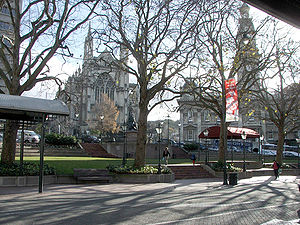
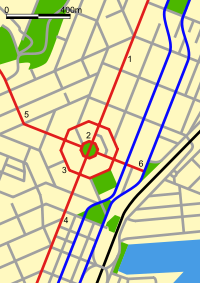
Dunedin
Dunedin is the second-largest city in the South Island of New Zealand, and the principal city of the Otago Region. It is considered to be one of the four main urban centres of New Zealand for historic, cultural, and geographic reasons. Dunedin was the largest city by territorial land area until...
, in the South Island
South Island
The South Island is the larger of the two major islands of New Zealand, the other being the more populous North Island. It is bordered to the north by Cook Strait, to the west by the Tasman Sea, to the south and east by the Pacific Ocean...
of New Zealand
New Zealand
New Zealand is an island country in the south-western Pacific Ocean comprising two main landmasses and numerous smaller islands. The country is situated some east of Australia across the Tasman Sea, and roughly south of the Pacific island nations of New Caledonia, Fiji, and Tonga...
.
Features
The Octagon is an eight sided plaza bisected by the city's main streetGeorge Street, Dunedin
George Street is the main street of Dunedin, the second largest city in the South Island of New Zealand. It runs for two and a half kilometres north-northeast from The Octagon in the city centre to the foot of Pine Hill. It is straight and undulates gently as it skirts the edge of the hills to its...
, which is called George Street to the northeast and Princes Street to the southwest. These form the axis of Dunedin's central business district
Central business district
A central business district is the commercial and often geographic heart of a city. In North America this part of a city is commonly referred to as "downtown" or "city center"...
.
Two other main thoroughfares intersect the Octagon: Upper and Lower Stuart Street
Stuart Street, Dunedin
Stuart Street is one of the main streets of Dunedin, New Zealand. As with many of Dunedin's streets, it is named after a main street in Edinburgh, Scotland....
s. Lower Stuart Street is the shorter of the two, leading 600 metres southeast to Dunedin Railway Station
Dunedin Railway Station
Possibly the best-known building in the southern half of New Zealand's South Island, Dunedin Railway Station is a jewel in the country's architectural crown. Designed by George Troup, the station is the fourth building to have served as Dunedin's railway station...
and to State Highway 1
State Highway 1 (New Zealand)
State Highway 1 is the longest and most significant road in the New Zealand roading network, running the length of both main islands. It appears on road maps as SH 1 and on road signs as a white number 1 on a red shield, but it has the official designations SH 1N in the North Island, SH 1S in the...
, which passes through central Dunedin as two parallel one way streets. Upper Stuart Street climbs steeply to the northwest as a major arterial route to the city's inner hill suburbs and beyond towards Three Mile Hill, one of the routes to the Taieri Plains
Taieri Plains
The Taieri Plains are an area of fertile agricultural land to the southwest of Dunedin, in Otago, New Zealand. The plains cover an area of some 300 square kilometres, with a maximum extent of 30 kilometres....
and South Otago
South Otago
South Otago lies in the south east of the South Island of New Zealand. As the name suggests, it forms the southernmost part of the geographical region of Otago....
. Surrounding the Octagon is a larger octagonal street, Moray Place
Moray Place, Dunedin
Moray Place is an octagonal street which surrounds the city centre of Dunedin, Otago, New Zealand. The street is intersected by Stuart Street , Princes Street and George Street...
.
The area within the roadway - with the exception of the central thoroughfare between George and Princes Streets - is a pedestrian reserve, grassed and terraced in the upper half, and paved in the lower. A street market occupies much of the paved area once a week. The terrace is surmounted by a statue by Sir John Steell
John Steell
Sir John Robert Steell RSA was a Scottish sculptor. He was born in Aberdeen on 18 September 1804, but his family moved to Edinburgh around one year after his birth. He is best known for a number of sculptures displayed in Edinburgh, including the statue of Sir Walter Scott at the Scott Monument...
of the Scottish
Scotland
Scotland is a country that is part of the United Kingdom. Occupying the northern third of the island of Great Britain, it shares a border with England to the south and is bounded by the North Sea to the east, the Atlantic Ocean to the north and west, and the North Channel and Irish Sea to the...
poet Robert Burns
Robert Burns
Robert Burns was a Scottish poet and a lyricist. He is widely regarded as the national poet of Scotland, and is celebrated worldwide...
, whose nephew, Thomas Burns
Thomas Burns (New Zealand)
Thomas Burns was a prominent early European settler and religious leader of the province of Otago, New Zealand.Burns was baptised at Mauchline, Ayrshire, Scotland in April 1796, the son of estate manager Gilbert Burns, who was the brother of the poet Robert Burns...
was one of the founders of the city.
Several of Dunedin's significant buildings and institutions face this plaza or closely adjoin it. They include the Dunedin Municipal Chambers (Dunedin Town Hall
Dunedin Town Hall
The Dunedin Town Hall is a municipal building in the city of Dunedin in New Zealand. It is located in the heart of the city extending from The Octagon, the central plaza, to Moray Place through a whole city block. It is the seat of the Dunedin City Council, providing its formal meeting chamber, as...
), Civic Centre and Public Library
Dunedin Public Libraries
Dunedin Public Libraries is a network of five libraries and two bookbuses in Dunedin, New Zealand, owned and operated by the Dunedin City Council. The libraries collection includes over 700,000 items, and around 30,000 books and audiovisual items plus 15,000 magazines are added each year...
, the Regent Theatre
Regent Theatre, Dunedin
The Regent Theatre is a theatre in Dunedin, New Zealand with a seating capacity of about 1,650. It is in The Octagon, the city's central plaza, directly opposite the Municipal Chambers and close to the Dunedin Public Art Gallery....
(Dunedin's largest live theatre), Dunedin Public Art Gallery
Dunedin Public Art Gallery
The Dunedin Public Art Gallery holds the main public art collection of the city of Dunedin, New Zealand. Located in The Octagon in the heart of the city, it is close to the city's public library, municipal chambers, and other facilities such as the Regent Theatre.-History:The gallery was founded by...
, and St. Paul's Cathedral
St. Paul's Cathedral, Dunedin
St Paul's Cathedral is the mother church of the Anglican Diocese of Dunedin, in New Zealand and the seat of the Bishop of Dunedin.-Location:The Cathedral Church of St Paul occupies a site in the heart of The Octagon near the Dunedin Town Hall and hence Dunedin...
. Other buildings are the Athenaeum and Mechanics Institute and a multiplex cinema
Movie theater
A movie theater, cinema, movie house, picture theater, film theater is a venue, usually a building, for viewing motion pictures ....
. Several restaurants and bars are located here. There is also provision for open-air dining.
The Octagon is a major hub
Spoke-hub distribution paradigm
The hub-and-spoke distribution paradigm is a system of connections arranged like a chariot wheel, in which all traffic moves along spokes connected to the hub at the center...
for public transport in Dunedin
Public transport in Dunedin
Public transport in Dunedin, New Zealand is mainly by bus. Three bus companies operate routes under their respective brands, co-branded with the Otago Regional Council as "GoBus"...
; the bus stops are actually mostly on approaching streets with one main stop in the south-west quadrant, outside Hoyts cinema. Taxi
Taxicab
A taxicab, also taxi or cab, is a type of vehicle for hire with a driver, used by a single passenger or small group of passengers, often for a non-shared ride. A taxicab conveys passengers between locations of their choice...
stands occupy most of the north-east quadrant.
History
The Octagon was first laid out during Charles KettleCharles Kettle
Charles Henry Kettle surveyed the city of Dunedin in New Zealand, imposing a bold design on a challenging landscape. He was aiming to create a Romantic effect and incidentally produced the world's steepest street, Baldwin Street....
's surveying of the city in 1846. His plans for the centre of Dunedin included a large Octagonal area (Moray Place
Moray Place, Dunedin
Moray Place is an octagonal street which surrounds the city centre of Dunedin, Otago, New Zealand. The street is intersected by Stuart Street , Princes Street and George Street...
) enclosing a smaller octagonal space, originally designated as a reserve. This status was embodied in law in 1854, six years after the arrival of the first European settlers to the city. At this stage in Dunedin's history the area was officially designated as "the Square of Moray Place", though it was colloquially known as the Octagon even then.
Despite the reserve status, the Anglican Church sought to build in the centre of the Octagon, applying directly to Governor
Governor-General of New Zealand
The Governor-General of New Zealand is the representative of the monarch of New Zealand . The Governor-General acts as the Queen's vice-regal representative in New Zealand and is often viewed as the de facto head of state....
Sir George Grey
George Grey
George Grey may refer to:*Sir George Grey, 2nd Baronet , British politician*George Grey, 2nd Earl of Kent *Sir George Grey , Governor of Cape Colony, South Australia and New Zealand...
. It was not until construction was about to begin that the local (predominantly Presbyterian) community became aware of what was happening. This resulted in a major furore. Otago Superintendent William Cargill
William Cargill
William Walter Cargill was the founder of the Otago settlement in New Zealand, after serving as an officer in the British Army. He was a Member of Parliament and Otago's first Superintendent.-Early life:...
was put in charge of resolving the dispute, which resulted in the Anglicans being forced to withdraw their plans for The Octagon. (The Anglican St. Paul's Cathedral
St. Paul's Cathedral, Dunedin
St Paul's Cathedral is the mother church of the Anglican Diocese of Dunedin, in New Zealand and the seat of the Bishop of Dunedin.-Location:The Cathedral Church of St Paul occupies a site in the heart of The Octagon near the Dunedin Town Hall and hence Dunedin...
stands today at its northern edge.)
For many years, the site was somewhat derelict, with little done to improve the condition of the reserve. Early central Dunedin was divided by the body of Bell Hill, which rose immediately to the south of The Octagon. It was only with the making of a cutting through the hill and the later removal of most of it to allow traffic to move easily between the northern and southern parts of the central city along Princes Street that The Octagon began to gain any prominence. Even so, it remained unsightly until the 1890s.
The first major structure of any kind in The Octagon's reserve area was a monument erected in 1864 to the memory of Cargill. This was moved several hundred metres to The Exchange in 1872 to allow for the construction of a central roadway connecting Princes Street and George Street. In 1887 a statue of the poet Robert Burns
Robert Burns
Robert Burns was a Scottish poet and a lyricist. He is widely regarded as the national poet of Scotland, and is celebrated worldwide...
, the uncle of one of the city's founding fathers, was unveiled. It still stands at the western edge of The Octagon close to the junction with Stuart Street
Stuart Street, Dunedin
Stuart Street is one of the main streets of Dunedin, New Zealand. As with many of Dunedin's streets, it is named after a main street in Edinburgh, Scotland....
.
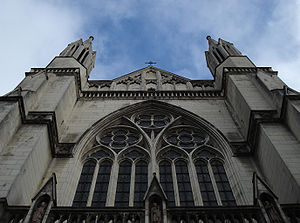
Thomas Burns (New Zealand)
Thomas Burns was a prominent early European settler and religious leader of the province of Otago, New Zealand.Burns was baptised at Mauchline, Ayrshire, Scotland in April 1796, the son of estate manager Gilbert Burns, who was the brother of the poet Robert Burns...
, though this monument, erected in 1891, was generally unpopular and was eventually removed during the 1940s. Subterranean public toilets were installed close to the monument in 1910, though these were filled in in the 1970s.
In 1963, the council was given £5,000 by the Evening Star
Evening Star (Dunedin)
The Evening Star was a daily evening newspaper published in Dunedin, New Zealand from June 1863. Second-longest lasting of Dunedin's newspapers, it was the only rival to the Otago Daily Times to survive beyond the first few years of the twentieth century.The Star - as the paper was originally...
newspaper to build a fountain in the Octagon. The Star Fountain, as it became known after its installation in 1966, was a popular attraction, with synchronised lighting, music and water displays, which played at regular times of the morning and evening. Despite its popularity, it was also unsightly during times when it was not playing, due to the large number of visible pipes needed for its performances. When The Octagon was refurbished in the 1990s, the Star Fountain was removed and was not included in The Octagon's new design, leading to some public outcry.
Renovation
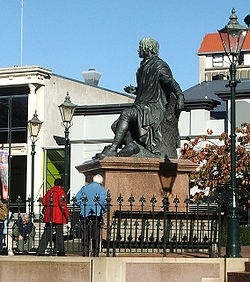
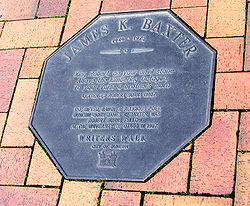
The "new look" Octagon was in many ways an "old look", with covered walkways and Edwardian-styled streetlights and fittings giving an antique look to the central city, complementing the many late Victorian and Edwardian buildings which surround The Octagon.
Improvements also included the paving of a plaza area in the lower Octagon (an area now regularly used for street performances and markets). The renovation of The Octagon, and particularly the addition of a plaza area, has seen an increase in al fresco dining in The Octagon, which is now a major hub for Dunedin's restaurant and cafe culture.
The renovation of The Octagon also saw the installation of two walks featuring large plaques embedded in the paving. The larger of these is a "Writers' walk", featuring plaques inscribed with words from famous Dunedin writers and words about Dunedin by famous visiting writers. This walk extends around much of the upper Octagon. A second, smaller, walk along the central carriageway of The Octagon features plaques dedicated to Dunedin-born or based Olympic
Olympic Games
The Olympic Games is a major international event featuring summer and winter sports, in which thousands of athletes participate in a variety of competitions. The Olympic Games have come to be regarded as the world’s foremost sports competition where more than 200 nations participate...
medallists.
See also
- Aotea SquareAotea SquareAotea Square is a large paved public area in the CBD, of Auckland, New Zealand. Officially opened in 1979 by Sir Dove-Myer Robinson next to Queen Street, it is used for open-air concerts and gatherings, and markets and political rallies....
, Auckland - Civic Square, WellingtonCivic Square, WellingtonCivic Square is an open public area at the centre of Wellington, New Zealand. It marks the boundary between the financial district to the north and the entertainment district to the south.- Textures and materials :...
- Cathedral Square, ChristchurchCathedral Square, ChristchurchCathedral Square, locally known simply as the Square, is the geographical centre and heart of Christchurch, New Zealand, where the city's Anglican cathedral, ChristChurch Cathedral is located...

